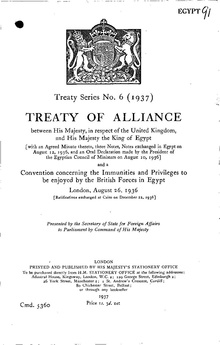Anglo-Egyptian treaty of 1936
| Type | Bilateral treaty |
|---|---|
| Signed | 26 August 1936 |
| Location | London, England, UK |
| Original signatories | |
| Ratifiers |
|

The Anglo-Egyptian Treaty of 1936 (officially, The Treaty of Alliance Between His Majesty, in Respect of the United Kingdom, and His Majesty, the King of Egypt) was a treaty signed between the United Kingdom and the Kingdom of Egypt.
Under the terms of the treaty, the United Kingdom was required to withdraw all its troops from Egypt, except those necessary to protect the

Background
In November 1918, seven prominent Egyptians from the landed gentry and the legal profession, including
Wafdist leaders thought that the ideas of independence and constitutional government were closely related and they had someone to model themselves after - the British. Following the proclamation of the Egyptian Constitution of 1923 the 1923–24 Egyptian parliamentary elections were held. Many European-educated Egyptians believed that the mere existence of a constitution and a parliament would legitimise Egyptian claims for complete independence.[2]
But Egyptian democratic independence ran into many obstacles; the nature of the constitution gave many powers to the king, including the power to dissolve parliament. So the king used this constitutional power to get rid of parliament when they went against his wishes, culminating in many periods of royal rule. The British also continued to meddle in Egyptian politics, and they did not allow for a fully independent political apparatus to develop. Also the Wafd party and other minor political parties never created a coalition to stand together against the British, instead they held each other in contempt. The result of these obstacles was a constant struggle for power between the British-backed
The intense desire for real independence was only partially fulfilled in 1936, when Britain agreed to renegotiate the 1922 declaration of independence, because of Italian expansionism into Ethiopia in 1935.[2]
Among the pretexts for the treaty was the
Treaty signing
The Treaty was signed in the Locarno Room at the Foreign Office building in London on 27 August 1936.

Other signatories included
Treaty provisions
- Removal of military forces from the Egyptian cities to the Suez Canal area but British soldiers in Sudan remain unconditionally.
- The number of British troops in Egypt to number no more than 10 thousand soldiers and 400 pilots with the staff required for administrative and technical work in peacetime only, while during a state of war the UK has the right to increase the number.
- British forces are not transferred to new areas until new barracks are built.
- British troops remain in Alexandria eight years from the date of the Treaty
- British air forces remain in the camp in the Canal Zone and are entitled to use Egyptian air space and the same right is given to Egyptian aircraft.
- In case of war the Egyptian government is committed to provide all facilities and assistance to the British forces including the right to use Egyptian ports and airports and roads.
- After 20 years from the implementation of the Treaty parties it shall be determined if the presence of British troops is necessary as the Egyptian army may be able to guarantee shipping in the Suez Canal safely. Disagreements may be submitted to the League of Nations.
- Egypt has the right to demand the abolition of foreign privileges.
- Cancel all agreements and documents contrary to the provisions of this Treaty including the February 28 statement
- The return of the Egyptian army to Sudan and the recognition of joint management with Britain.
- Freedom of Egypt to make treaties with foreign countries, provided that these are not inconsistent with the provisions of this Treaty.
- Exchange ambassadors with Great Britain.
Aftermath
On 23 September 1945, after the end of

Following the abrupt withdrawal of an offer by Britain and the United States to fund the building of the Aswan Dam, Egypt nationalised the Suez Canal on 26 July 1956,[8] ostensibly to pay for the dam, although in reality the Soviets provided most of the funding. The nationalisation was technically in violation of the international agreement that Nasser had signed on 19 October 1954, although he agreed to pay compensation to the shareholders. Some months later, France, Israel and Britain colluded to overthrow Nasser,[9] and the Suez Crisis ensued.
References
- General
- Specific
Cleveland, Bunton (2013). A History of the Modern Middle East. Boulder: Westview Press.
- ^ League of Nations Treaty Series, vol. 173, pp. 402–431.
- ^ a b c Cleveland, Bunton (2013). A History of the Modern Middle East. Boulder: Westview Press.
- ^ Robert O. Collins, A History of Modern Sudan
- ^ a b c "Egyptian Treaty". The Times. London. 22 August 1936. Retrieved 7 November 2021.
- ^ "Historic Anglo-Egyptian treaty signed in London – archive, 1936". The Guardian. 27 August 2021. Retrieved 28 August 2021.
- ISBN 0-313-24308-5.
- ^ a b "Middle East 1930 - 1947:British Troops in Egypt 1930 - 45". britishmilitaryhistory.com. Retrieved October 30, 2022.
- ^ "Suez crisis" The Concise Oxford Dictionary of Politics. Ed. Iain McLean and Alistair McMillan. Oxford University Press, 2003.
- ^ Avi Shlaim, The Protocol of Sèvres,1956: Anatomy of a War Plot Published in International Affairs, 73:3 (1997), 509–530
External links
- "Full Text of the Treaty". Foreign and Commonwealth Office. Archived from the original (PDF) on 24 September 2012. Retrieved 23 February 2010.
- Video of the treaty signing

